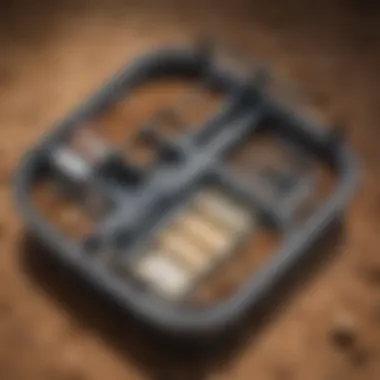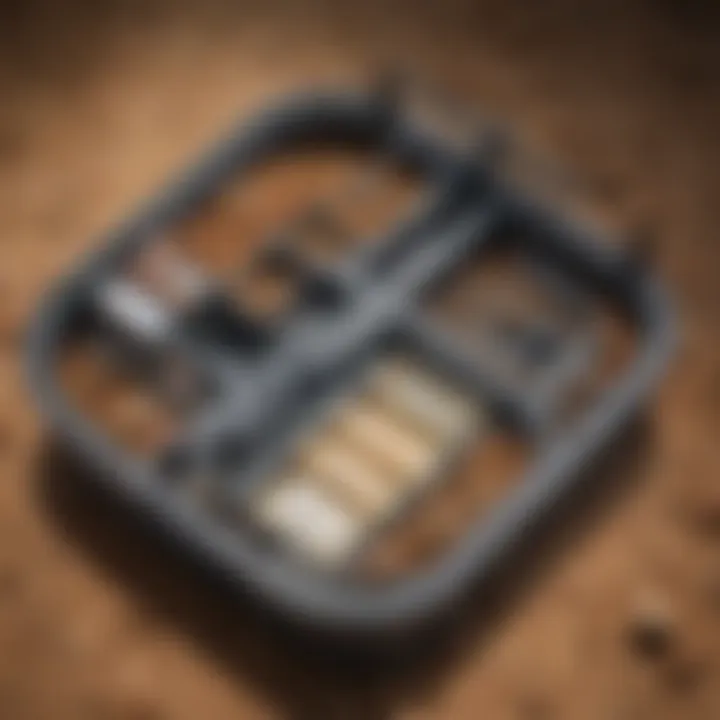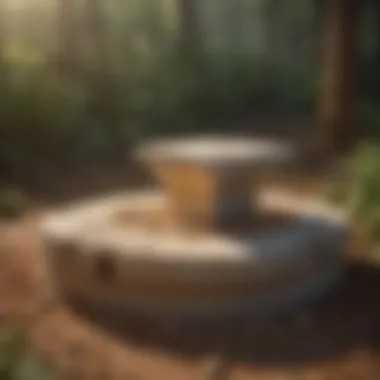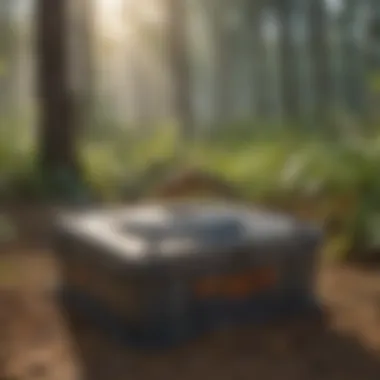Understanding Termite Control Bait Stations: A Comprehensive Overview


Preventive Pest Control Strategies
Effective pest control begins with preventive measures. Understanding these strategies can help homeowners reduce the risk of infestations before they even become a problem. Below are key areas to consider.
House Exterior Protection
Homeowners can employ specific tactics to secure their house from pests, especially those that are sneaky. Here are some effective tips:
- Sealing cracks: Inspect your home regularly for cracks in the walls and around utility lines. Using caulking material can prevent pests from entering.
- Clearing debris: Keep the area around your home free from clutter. Fallen leaves, wood piles, and other debris can attract rodents and insects.
- Preventing pests from entering: Installing door sweeps and window screens can reduce openings that pests may exploit. Additionally, check and repair screens to ensure they are intact.
Yard Maintenance
Your yard is a vulnerable spot for pest attraction. Regular maintenance is crucial. Consider these essential routines:
- Lawn care: Mow your lawn regularly to avoid tall grass, which can harbor insects.
- Trimming trees and shrubs: Keep branches trimmed at least three feet away from your house. This prevents pests from using foliage as a bridge.
- Mulching properly: Use mulch that is chemical-free to avoid luring pests. Avoid mulching too close to your foundation.
Indoor Cleanliness
A clean interior will also reduce the risk of pest infestation. Here are useful expert tips:
- Routine cleaning: Frequently clean your kitchen, especially around appliances and food storage area.
- Food storage: Store food in sealed containers and avoid leaving food exposed.
- Regular vacuuming: Vacuum often, focusing on corners and hidden spots where pests might thrive.
Garbage Disposal
Proper garbage disposal can greatly influence pest populations. Employ these methods:
- Secure bins: Make sure garbage cans are tightly sealed.
- Frequent disposal: Dispose of waste regularly and do not leave bags lying around.
- Landfill practices: Compost bins must be well-licenced and used correctly, ensuring that they do not become attractive to unwanted critters.
Other Pest Prevention Strategies
Integrating innovative methods is useful for safeguarding your home.
- Planting pest-repelling plants: Certain plants like marigolds and mint can deter pests naturally.
- Bright lights: Installing bright lights outside can discourage insects from approaching your house at night.
- Physical barriers: Using hardware cloth around vents and foundations can keep pests from wandering inside.
Preventive care is more than just a model; it's a crucial first step in becoming of strong defenses against pests.
Identifying vulnerable areas around your home is essential for tackling pest-related problems efficiently. Let’s now explore vital inspection tactics.
Foreword to Termite Control
Termite control is a critical area of focus for many homeowners and property managers. It involves systematic approaches to manage and mitigate the damage caused by termites, which can be significant if left unchecked. Understanding the methods for termite control is essential for protecting structures and ensuring their longevity. The employement of termite control solutions such as bait stations can honorably offer real benefits when strategically utilized.
In this article, we will emphasize several aspects related to the introduction of termite control, especially focusing on education about the species that cause harm and the impacts of such infestations on structures.
Overview of Termite Species
Termites are more than simply pests to avoid; they belong to a complex family of insects with diverse characteristics. Broadly, there are three main types of termites: subterranean, drywood, and dampwood. Understanding these classifications is crucial.
- Subterranean Termites: These are the most common and destructive type. They live underground and create extensive tunnel systems. Generally, Formosan Termites, a subgroup of subterraneans, pose severe threats due to their aggressive behavior and size of colonies.
- Drywood Termites: They inhabit dry wood above ground. As they do not require soil moisture, they can infest wooden structures directly. This type of termite can prove a challenge as they can be harder to identify based on soil disturbances.
- Dampwood Termites: Preferring flourished objects or material with a higher moisture interest, these capitalists are often problematic in rainy climates. They require large amounts of moisture to thrive.
Identifying which species are attacking your property is the first step in effective termite control. Each species has different behaviors, nesting habits, and thus requires tailored approaches in management.
Impact of Termites on Structures
Termites can have severe consequences for both residential and commercial structures.
- Structural Damage: Over time, the continuous tunneling will weaken the building's integrity. Characters such as shape, soil, and timber quality affect the damage rate. Subterranean species particularly make Colony* feeding caused by excessive wood damage that can lead to enormous repair costs.
- Financial Impact: The financial toll extends beyond physical repairs. Insurance premiums may increase, stressing economic well-behavior during such repairs. Cost inerventions in IT aren’t merely incidental when preventive measures are neglected.
“An effective strategy uses early reognition of potential termite threats. Investing in maintenance before a fully-fledged infestation can save significant amounts over time.”
- Health Concerns: While termites themselves do not carry parasites, their damage can lead to other pests, which might pose health issues for inhabitants.
Applying methodological pest control strategies decisively can pvercome these challenges, aligning with sustainable long-term benefits for all concerned.
The knowledge we provide concerning species and their impacts allows homeowners to build a formidable defense surface against these destructive insects.


What Are Termite Control Bait Stations?
Termite control bait stations play a crucial role in managing the threat posed by termites. They serve as a targeted method to eliminate these destructive insects while minimizing the use of broader pesticide applications. Understanding the specific elements involved in bait stations, what they do, and their benefits is essential for effective termite management. This section explores the nuances of bait stations and why they matter.
Definition and Purpose
Termite bait stations are devices strategically installed around a property to attract and eliminate termites. The definition may sound simple, yet their purpose extends beyond mere visibility. The effective design resonates with the behavior of termites, making it possible to lure them from their natural habitat. Instead of face-on confrontation like sprays or powders, bait stations operate more subtly and efficiently.
By utilizing bait stations, homeowners can significantly reduce damage risks by targeting termite colonies where they nest. The mechanism typically involves a slow-acting substance that, once consumed, prevents termites from thriving in both their colonies and their ecosystem. This turns bait stations into not only control measures but prevention tools.
Components of a Bait Station
Specific components make up an effective bait station. Understanding these elements contributes to an informed selection process if deciding to use bait stations for termite control.
- Station Body: Made from weather-resistant materials to withstand environmental conditions.
- Access Ports: Allow termites entry while keeping out unwanted substances. They provide a spot for placement of feeding bait, crucial for drawing termites in.
- Bait: Typically a cellulose material infused with a slow-acting termiticide. Not just any substance, but a carefully crafted blend that entices termites without raising immediate red flags to their survival instincts.
- Monitoring System: Many modern models come equipped with a monitoring component. This enables homeowners to gauge activity levels within a specific area, offering clues about where termites are active.
- Installation Method: Usually, bait stations require proper placement in the correct types of soil compositions. Depending on environmental conditions such as moisture levels, they may be set deeper or shallower.
Adopting such technology making termite management more advanced should appeal to home owners looking for effective pest solutions.
Key Insight: Bait stations, when installed correctly, can serve a dual purpose: A preventive measure as well as a treatment method. These components work cohesively to ensure bait stations remain effective throughout their functioning life, which is dependent on regular maintenance.
Thus, understanding bait stations fundamentally changes one's approach to termite control, emphasizing targeted tactics and preventative measures over more indiscriminate sprays.
Types of Termite Bait Stations
The significance of understanding the different types of termite bait stations lies in their effective role in pest management practices. Each category offers distinct approaches suited to various situations and termite behaviors. Additionally, knowing the unique characteristics can help homeowners and pest control professionals choose the best strategy for termite eradication.
Below-Ground Bait Stations
Below-ground bait stations are designed for installation underground, usually surrounded by soil. These stations attract subterranean termites—one of the most threatening types of termites as they can cause significant damage.
Decorator an main advantages include:
- Discreet Operation: Their concealment ensures minimal disruption to the yard while effectively luring termites and treating infestations below the surface.
- Higher Efficacy: Since they engage with the site of infestation, conditions and moisture levels tend to be more favorable for attracting termites.
Installation typically involves digging a hole and placing the station at least a foot away from a foundation wall, ensuring easy access to termites. Refillable bait cartridges provide ongoing treatment, further safeguarding properties.
Above-Ground Bait Stations
Above-ground bait stations are strategically positioned on the surface to target existing termite infestations in wood or structural elements. These systems work by using bait to draw termites directly to the wood products they are infesting.
Key highlights with above-ground bait stations include:
- Immediate Impact: Fast removal of active infestations can bolster the integrity of buildings. This is imperative when signs of termites have been detected during examinations.
- Controlled Environment: Positioning bait above ground allows for easier maintenance, inspections, and replacements of bait material.
Most effectively placed near areas of known activity, it's essential to refill and maintain these stations frequently, particularly after heavy rains that can affect woodland environments.
Comparison of Bait Station Types
When contrasting below-ground and above-ground bait stations, both systems deliver efficacy; distinct traits make them more suited for specific conditions. Here are some aspects to consider:
- Type of Termite Targeted: Below-ground stations target subterranean variants, while above-ground versions help combat drywood infestations directly.
- Ease of Monitoring and Maintenance: Above-ground bait stations are easier to evaluate over time, while below-ground types necessitate periodic checks, ideally ensuring each station is kept free from debris and other environmental factors that may hinder, efficiency.
Effective termite management requires a comprehensive understanding of product types and their deployment for lasting results.
Mechanism of Action
Understanding the mechanism of action for termite bait stations is crucial for multiple reasons. It highlights how these systems effectively lure termites and subsequently control their populations. The psychological and natural tendencies of termites influence how bait stations function. Recognizing this mechanism allows for effective monitoring and strategic implementation, leading to improved outcomes in termite management.
How Bait Stations Attract Termites
Termites are motivated primarily by the need for food and shelter. Bait stations leverage this behavior by featuring substances that are appealing to these insects. Typically, bait stations use attractive wood or cellulose, often treated with an insecticide at lower concentrations.
The bait is designed to mimic the natural food sources termites seek, such as decaying wood or roots. Once a termite encounters the bait, its natural instinct to forage drives it toward the station. This gathering behavior is essential; when termites are drawn to the bait station, they inadvertently disturb their existing colonies, spreading the bait further as they return home.
Process of Bait Consumption


Once termites arrive at a bait station, the process of consumption begins. Termites use their mandibles to nibble on the bait, which they can either directly eat or bring back to their colonies. This behavior demonstrates the critical nature of their social structure.
When the first worker termites eat the bait, it does not kill them outright. Instead, the ingredients in the bait act slowly. As these termites return with the bait to share with their colony, including soldiers and reproductive members, they facilitate a further spread of the active ingredient. The ritual of mutual feeding within the colony ensures that a larger number of termites is exposed to the active substances in the bait. Proper bait consumption goes through stages, from initial consumption to eventual exposure of many colony members.
Effects of Bait on Termite Colonies
The ultimate goal of termite bait stations is not only to reduce the visible presence of termites but also to impact their colonies. The ingestion of the bait active ingredients disrupts the termites' development, preventing castes from effectively functioning. As termites continue to share the bait—through mutual feeding—several members become incapacitated.
Over time, the mate selection and reproductive abilities of the colony decline, leading to long-term eradication. Moreover, depending on the ingredients used, certain baits can also lead to colony collapse due to a breakdown in the social structure. Such effects reinforce why detailed knowledge about the bait and its features remain an integral aspect of effective termite control.
Proper use of bait stations requires understanding their mechanisms to ensure efficiency in handling termite infestations.
A successful termite management strategy recognizes the importance of consistent monitoring of both the activity within bait stations and broader colony dynamics. Understanding the interconnected nature of these processes leads to enhanced effectiveness in controlling termite populations.
Effectiveness of Bait Stations
The effectiveness of bait stations plays a crucial role in any termite management strategy. Understanding how various factors influence their performance helps homeowners select the right method to address termite infestations. While these systems have apparent benefits, their efficacy can fluctuate based on multiple variables like placement, material choice, and environmental conditions.
Factors Affecting Efficacy
The efficacy of bait stations is influenced by a range of factors. Here are the key elements to consider:
- Type of Termite: Different termite species respond differently to bait. For instance, Reticulitermes and Coptotermes may show contrasting preferences for specific bait formulas. Knowing which species is prevalent in your area aids in selecting an optimal bait station.
- Placement and Number: Proper placement is vital. Bait stations should be located near high termite activity areas, such as near woodpiles or damp spots. Inadequate placement or too few units can significantly reduce effectiveness.
- Environmental Conditions: Weather can impact the performance of bait stations. Rain or humidity may affect the bait properties and its attractiveness. Bait should remain palatable despite various weather conditions.
- Monitoring Regimen: Routine checking is essential to determine consumption rates. If the bait is consumed quickly, it may indicate heavy termite activity and necessitate additional bait stations.
By considering these factors, owners can improve the chance of effective termite control through bait stations.
Comparative Studies with Liquid Treatments
It is essential to compare bait stations with liquid treatments. Various studies show significant differences in terms of both interactivity and effectiveness.
An analysis articulated that bait stations tend to act more slowly compared to liquid applications. While liquid treatments provide immediate suppression of active termites, bait stations offer a more systemic approach that focuses on colony elimination over time.
Research illustrates these points:
- Long-Term Effectiveness: When evaluated, bait stations lead to long-term colony reduction. They facilitate a die-out effect as termites ingest the bait and carry it back to the colony.
- Environmental Impact: Bait systems are usually safer for the environment, using lower volumes than liquid treatments. They less frequently interact with non-target organisms, making them a more ecologically sound choice.
- Cost Efficiency: Although liquid treatments show quick results, a study has shown that they can be more costly over time, considering ongoing applications. In contrast, bait stations generally incur lower recurring costs due to their prolonged effect on colonies.
Evaluating each option in relation to the unique needs and local termite pressure ensures home and property owners choose the best method for termite management while balancing effectiveness and safety.
Installation of Bait Stations
The installation of bait stations plays a critical role in termite management. It simply can determine whether the control approach succeeds or fails. A proper installation not only enhances the chances of attracting termites but also ensures maximum efficacy of the bait used. As such, understanding the nuances related to installation should not be overlooked by housewives or house owners.
There is a clear, systematic approach needed while installing these systems. Choosing the right location and following a methodical installation process can prevent infestations from causing significant damage to your home structure.
Site Selection and Preparation
Site selection is the first major step when installing bait stations. Key considerations include areas that show signs of termite activity. Identifying potential hotspots around your home is crucial. Look for the following signs:
- Mud tubes on walls or surfaces
- Frass, or termite droppings
- Damp wooden areas that feel soft
Pay attention also to moisture levels, as termites thrive in these environments.
After identifying the locations, prepare your site. Remove debris, leaves, or any culverts that may prevent bait stations from effective operation. The objective is to ensure that the bait remains easily accessible to termites.
Step-by-Step Installation Process
Once the site is prepared, one can proceed to the installation process. Here is a step-by-step guide:
- Gather necessary tools: Ensure you have all tools, which usually include a trowel, gloves, and the bait station parts.
- Dig the holes: Set the bait stations at least ten feet apart, approximately 12 to 18 inches deep.
- Insert bait station: Place the bait station into the hole, ensuring it stays upright and stable.
- Add bait: Insert the bait into the station, following the manufacturer's guidelines. Easy access to food attracts termites.
- Check alignment: Ensure the ground surface levels with the top of the bait station, making it unobtrusive, yet forwarding those food resources.
- Cover with soil: Once installations are finished, cover the station with soil or mulch to facilitate its acceptance by terrestrial termites.
- Document the placements: Keep records of each station, marking locations accurately for easy monitoring in the future.
Following this guide for installations increases the overall success rates and helps manage the termite infestation more effectively.
Important: Regular follow-ups and checks are essential to represent any potential changes in termite behavior. Ignoring this duty could cost you worsening damages to your property.
Adopting these techniques will foster a proactive control method against termite infestations in your home.


Monitoring and Maintenance
Monitoring and maintenance of termite control bait stations are integral to their effectiveness. Without a proper system in place to observe and take corrective actions, the value of these interventions can diminish. The primary goals of this practice are to ensure that bait stations are functioning effectively and to minimize any potential damage that a termite colony may cause before it becomes significant. Let’s dive into some essential components of monitoring and maintenance for bait stations.
Regular Inspection Schedule
A systematic inspection schedule is crucial. Setting a regimen for checking bait stations permits early detection of issues or changes in termite activity. Homeowners should inspect bait stations at least once a month, particularly in warmer months when termites are most active. This frequency assures that intervals do not become too long, which can lead to missed signs of new infestations.
During inspections, check for physical damage to the bait stations and ensure that they are properly positioned. It is also advisable to record data for comparisons over time, which will help spot trends that may signify emerging problems. Observation should include noting how much bait is consumed and any signs of termites in the area surrounding the stations.
Identifying Signs of Termite Activity
Recognizing the signs of termite activity is essential for effective management. Indicators might include a decline in the bait within stations or swarming of termites near the property. Physical signs can be fragments of wings, hollow-sounding wood, or mud tubes leading into structures. Systematic checking for these signs allows homeowners to take decisive action before potential damage escalates.
- Signs to watch for:
- Drywood termite droppings, which resemble small pellets.
- Mud tunnels typically built by subterranean termites.
- Damaged wood that feels soft or sounds hollow.
Awareness of these signs reinforces the importance of maintaining the bait stations vigorously. The sooner termite activities are located, the quicker and more effective the response could be.
Refilling and Replacing Bait
Managing the bait level in stations is fundamental for maintaining effectiveness. Bait not only attracts termites but also ultimately controls their population. It's pivotal to maintain the right amount of bait at all times. Once termite activity is detected in a bait station, it becomes important to refill the bait promptly. Regular monitoring helps determine when and how much bait to refill.
When replacing bait, follow the manufacturer’s guidelines closely. Each type of bait station might have specific protocols, including when to remove and refill or how often to replace the bait itself. Here are a few steps to follow:
- Remove the existing bait and inspect for signs of damage or neglect.
- Clean the station to prevent mold or fungi growth.
- Replace with fresh bait as per the instructions.
Over time, if there is minimal activity detected, then it can also signify that there are no more termites to draw in, and cleaning the station may become necessary.
Maintaining an effective monitoring and maintenance routine can greatly reduce the risk of termite damage while ensuring that bait stations operate at peak efficiency.
Homeowners should regard monitoring and maintenance as a proactive rather than reactive approach. Recognizing this connection between regular inspections, signs of activity, and bait management highlights the importance of these critical tasks. Ensuring sustained action offers peace of mind and long-term protection from termites.
Integrated Pest Management Strategies
Integrated Pest Management (IPM) is a holistic approach to managing pests that emphasizes sustainability and reducing potential harm to the environment. Its importance cannot be understated when discussing termite control, especially considering the complex behavior and structures of termite colonies. By integrating bait stations with other control methods, homeowners can achieve better control outcomes, reduce chemical reliance, and increase long-term effectiveness in their termite management strategies.
Combining Bait Stations with Other Control Methods
One of the key elements of a successful IPM strategy is the combination of different pest control methods. Bait stations serve as an effective first line of defense against termites, but their functionality is heightened when used alongside other tactics. This multifaceted approach can include:
- Physical barriers: Installing physical barriers like steel mesh or foamed concrete during construction helps prevent termite access.
- Excavation: Regular excavation and inspection of soil around structures can reveal signs of insgorrvites.
- Liquid insecticide treatments: Using liquid treatments in conjunction with bait stations can provide an immediate reduction in termite populations.
This strategic layering can decrease the chances of termite reinfestation while facilitating effective management when colonies interact. Bait stations allow them to consume only what they eat, but mixing methods takes advantage of the availability of multiple approaches.
Role of Professional Pest Control Services
The expertise of professional pest control services enhances any termite management strategy. Professionals are equipped with knowledge about insect behavior and detection methods. They play a pivotal role in the final integration phase of IPM by:
- Conducting thorough inspections. They can accurately surveil areas for termite presence and determine the right tactics for specific situations.
- Advising on suitable combinations of bait systems with physical barriers or chemical treatments for maximum efficiency.
- Implementing advanced monitoring techniques that not only detect but quantify termite activity in residential settings.
Using professionals helps homeowners navigate complex environments where termite interactions vary significantly from one setting to another. They often recognize signs of infestation that can go unnoticed, thus amplifying the power of a proactive approach against these pests.
Professionals advocate that a tailored solution is more effective — IPM recognizes the value of customizing strategies based on individual property needs.
Integrating these several elements gives homeowners confidence that they are dealing with termite threats comprehensively, routinely revising strategies based on observed data. The interconnectedness fostered through IPM becomes essential because it provides what solely its parts cannot achieve — genuinely sustainable termite control.
Epilogue
The conclusion of this article emphasizes key insights about termite control bait stations. Those insights illuminate not only the pivotal benefits of these tools but also consider their inherent limitations.
Recap of Benefits and Limitations
Termite control bait stations offer several crucial benefits. Initially, they provide a discreet method of termite management. Setting them up can often cost less than traditional liquid treatments over time. In addition, bait stations target colonies directly, allowing for thorough elimination of the problem. However, some limitations exist. For instance, bait's effectiveness can vary based on the species of termites. It requires regular monitoring, which can demand time and expertise from the homeowner.
Bait stations are not a one-size-fits-all solution but play a critical role in integrated pest management—a comprehensive approach.
Future Perspectives on Termite Control
The future of termite control, including bait stations, is promising. Advancements in technology bring forth more effective bait formulations and more efficient station designs. There is growth in using smart monitoring systems, providing homeowners with real-time updates on bait status and termite activity. Consequently, your pest management strategy can become more proactive and less reactive, enhancing effectiveness.



